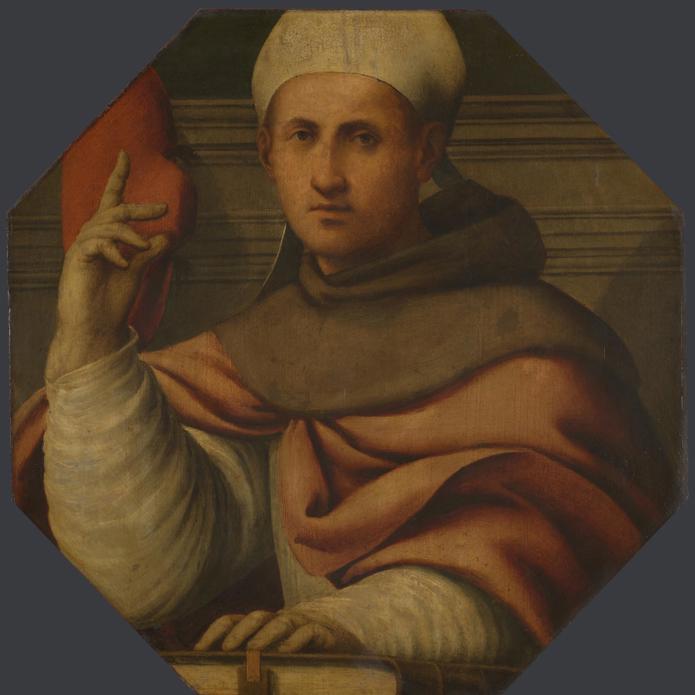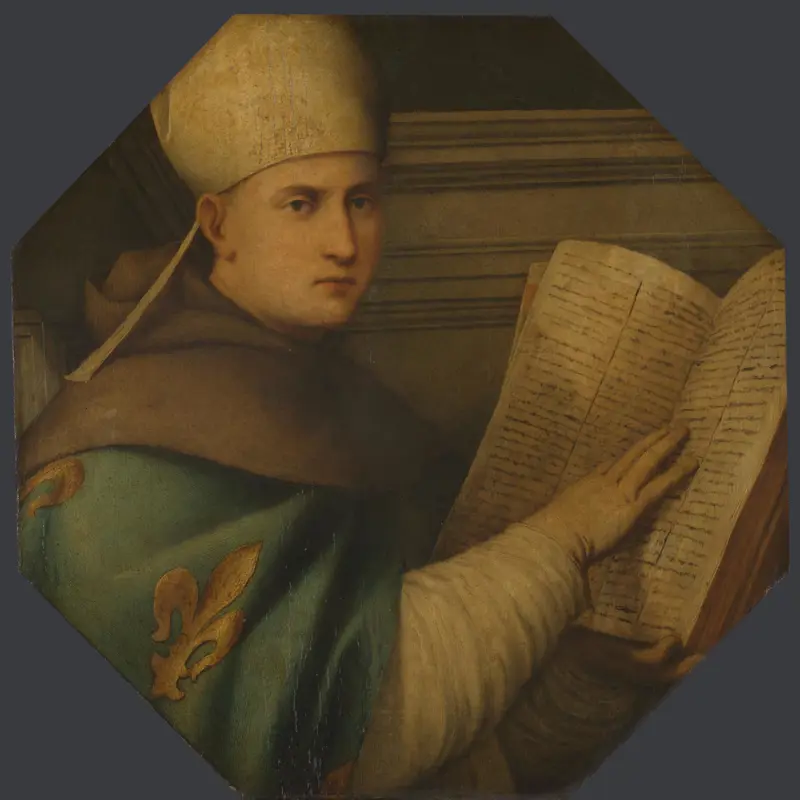Giovanni Antonio Pordenone, 'Saint Louis of Toulouse', probably 1530-5
About the work
Overview
This panel of Saint Louis of Toulouse and one of Saint Bonaventure, also in the National Gallery’s collection, are part of a series of nine paintings by Pordenone from a ceiling in the Scuola di S. Francesco ai Frari at Venice. The original arrangement showed the Four Evangelists on square panels in the corners, with Saints Bonaventure, Louis, Bernardino and Anthony of Padua in separate octagonal compartments around a central full length image of Saint Francis receiving the stigmata. The central panel of Saint Francis is lost but the Four Evangelists, Saint Bernardino and Saint Anthony are now in the Museum of Fine Arts, Budapest.
Saint Louis, who was consecrated Bishop of Toulouse in 1297, wears his bishop’s robes and holds a Bible. His cope is decorated with the French fleur-de-lis. He served the poor and fed the hungry, but after only six months as Bishop he abandoned the position, dying six months later. He was canonised in 1317.
Key facts
Details
- Full title
- Saint Louis of Toulouse
- Artist
- Giovanni Antonio Pordenone
- Artist dates
- Active 1504, died 1539
- Part of the series
- Ceiling Elements from a Venetian Scuola
- Date made
- Probably 1530-5
- Medium and support
- Oil on wood
- Dimensions
- 29.8 × 29.8 cm
- Acquisition credit
- Sir Claude Phillips Bequest, 1924
- Inventory number
- NG4039
- Location
- Not on display
- Collection
- Main Collection
Provenance
Additional information
Text extracted from the ‘Provenance’ section of the catalogue entry in Cecil Gould, ‘National Gallery Catalogues: The Sixteenth Century Italian Schools’, London 1987; for further information, see the full catalogue entry.
Bibliography
-
1959Gould, Cecil, National Gallery Catalogues: The Sixteenth Century Venetian School, London 1959
-
1987Gould, Cecil, National Gallery Catalogues: The Sixteenth Century Italian Schools, London 1987
-
2001
C. Baker and T. Henry, The National Gallery: Complete Illustrated Catalogue, London 2001
About this record
If you know more about this work or have spotted an error, please contact us. Please note that exhibition histories are listed from 2009 onwards. Bibliographies may not be complete; more comprehensive information is available in the National Gallery Library.
Images
About the series: Ceiling Elements from a Venetian Scuola

Overview
These two panels are said to have come from a ceiling in the Scuola di S. Francesco ai Frari at Venice. The ceiling originally featured the Four Evangelists on square panels at the corners, with Saints Bonaventure, Louis, Bernardino and Anthony of Padua in separate octagonal compartments around a central full length image of Saint Francis receiving the stigmata. The central panel of Saint Francis is lost but the Four Evangelists, Saint Bernardino and Saint Anthony are now in the Museum of Fine Arts, Budapest.
The National Gallery’s panels show Saint Louis of Toulouse in his bishop’s robes holding a Bible, and Saint Bonaventure pointing upwards. They are characteristic works of Pordenone’s late style and closely comparable with his Beato Lorenzo Giustiniani altarpiece (Accademia, Venice) commissioned in 1532, so were probably made at a similar time.


